

THE ART OF DISRUPTION
introduction
HELLO DEAR READERS,
Welcome to The Art of Disruption, issue three of No Permission Needed Zine (NPN). This publication is a compilation of work from Black and People of Colour (BPoC) across Scotland in response to the theme The Art of Disruption. The views and perspectives generously shared in this zine belong to the contributors, and don’t necessarily reflect the views of NPN.
I hope the following pages contain something that resonates with you, something that offers you food for thought, and something that makes you smile. A heartfelt thank you to everyone who has made it possible for you to be reading this.
Now that you’ve been welcomed, I’d like to offer a few key points that have informed my choice of disruption as our theme for this issue.
When I think of disruption I’m taken to many places, past and present. I think of worker strikes, hunger strikes, zine culture, protests, boycotts, and sit-ins. I also think of the everyday. I think of rest, community, friendship, honest expression of self, and of course, art.
For some time I’ve been reflecting on all of the above, and the significance of disruption as a tool used by marginalised people in struggles for liberation. I’ve been especially interested in the fact that both disruption and art, historically and presently, are used in tandem by those who are denied access to institutional and structural power.
In producing this zine, I do not aim to present a cohesive narrative about what disruption and art as disruption is. Nor do I wish to falsely claim that this zine is particularly radical or revolutionary. This publication is me, Hazel Peters, putting my thoughts on paper and inviting others to respond to the theme in whatever way they see fit.
This zine exists thanks to the many people who have kindly tended to this project. To the editorial team, Ebo, Eva, Pooja, we are small but mighty. Our meetings bring me much joy. I’m beyond grateful for your time and energy. To our wonderful contributors, without you there would be no issue 03, no Art of Disruption. Thank you for submitting your work. I hope that we’ve done you proud.
NPN has come a long way since I last sat down to write an introduction. Much love to everyone who has been a part of our journey. I look forward to wherever we go next.
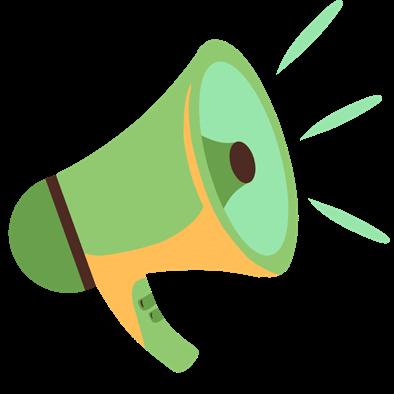
UNTIL NEXT TIME, HAZEL
About NPN: NPN began in 2021 as a project facilitated by the charity Intercultural Youth Scotland. Since becoming independent in 2022, NPN has continued to produce zines, and host community events. NPN aims to be a platform that celebrates the cultures, creativity, and experiences of Black and People of Colour (BPoC) in Scotland. The name No Permission Needed is an affirmation for taking up space; it is an invitation to cultivate approval and validation within ourselves. The Art of Disruption is their third zine issue.
burnout
WORDS BY EFFUA. ARTWORK BY MARYAM
You get used to being the only one in the room who looks like you. Side eyes, double glances, having to over-explain yourself.
I’m a ‘leader’ or a ‘healer’ I was told. That used to mean something to me. I envisioned my purple cape flowing through the air as I went out into the world to create harmony. ‘I’m strong’.
I told myself ‘They must listen to me’. If I hit them with the facts and reason. If I conduct myself the right way. If they knew what we had in common / maybe they could see what the word is like for someone like me.
But the issue was: I can’t explain my humanity to someone who doesn’t see me as human in the first place. It’s a dead end / I bared my soul to share but was met with side eyes, double glances and the need to over-explain myself. It made me angry. I started to harbour resentment, and I don’t want to harbour resentment. She’s ugly. She seeps into your daily life, slowly washing away the simple pleasure life is made for.
So I try again. But now I am tired / I forget to code-switch one day and the whole room looks confused. They nod their head and I smile politely. I am at a party. They’re playing the ‘classics’, I’ve never heard any of these songs before. I didn’t know who David Bowie was until I was 17.
You take your black male friend to that same party, they assume he’s the coke dealer.
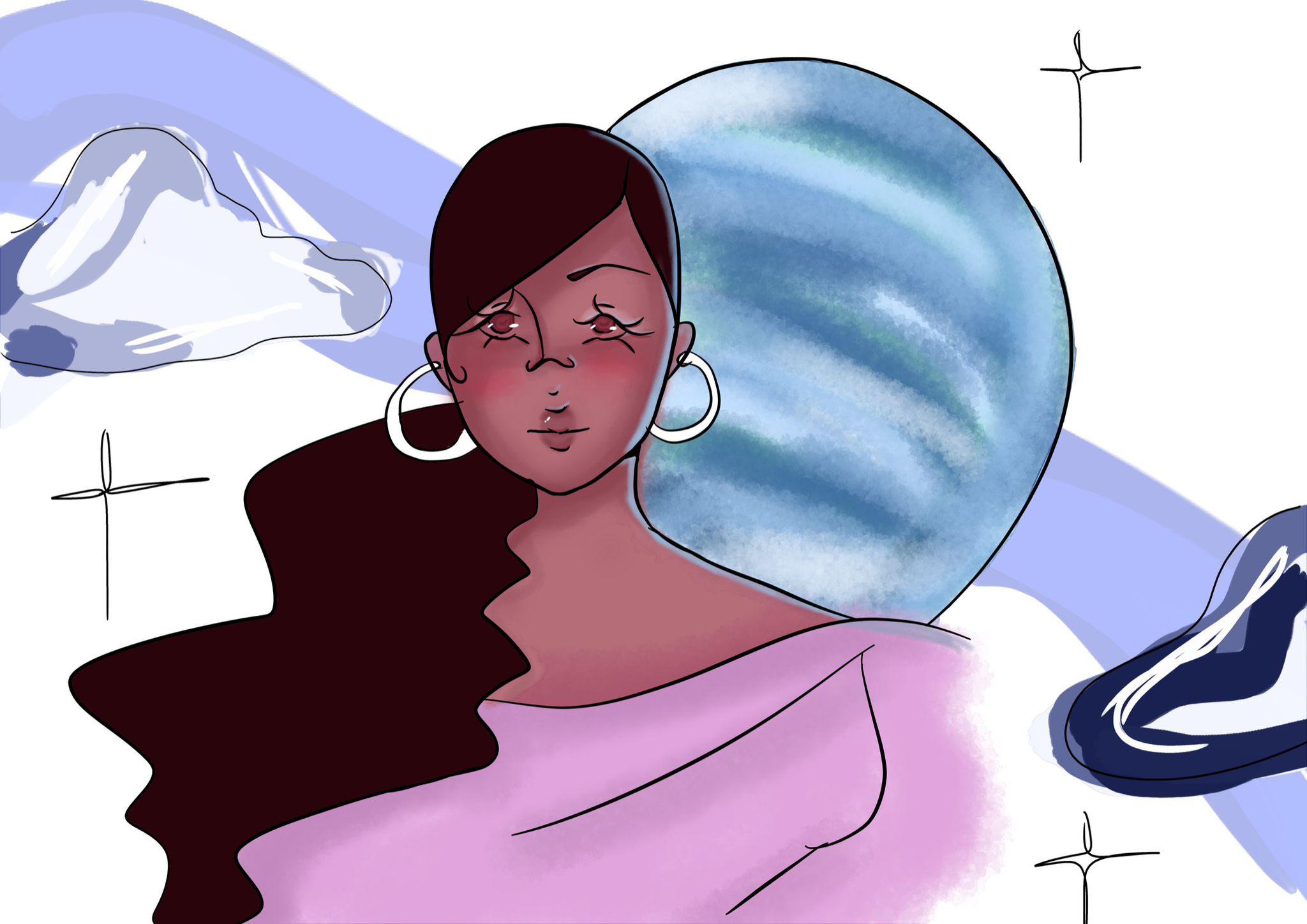
You go to the GP. You’re in pain. You cry when they laugh in your face. They say you’re exaggerating, but you’re in pain. You collapse and get rushed to hospital.
The image of yourself with the purple cape starts to fade away. You find yourself with your knees up in the corner having no idea how you got there. You don’t feel strong. You feel sore and sad and burnt out. You feel displaced.
You don’t want to lead or heal anymore. It’s tiring, having to explain your existence to people who have never bothered to learn. Sometimes you just want to be able to be. It’s a privilege we don’t acknowledge very often. The ability to walk into a space and be recognisable. Not having to hyperactively search for community. The ability to see yourself in the people who surround you. But sometimes, when your existence is political, you find yourself disgorged inside a vat of unfamiliarity. Swimming or sinking, knowing there’s no way out.
BY AISHWARYA.
Disabled Lens, My Lens
ARTWORK
BY MARYAM.
what does my world look like? black and white are only two colors an array of rainbow unicorn fills my world i have longed to run on the path and scream my lungs i am screaming through the passage of art art that is sensual and naked opaque and transparent whispering to me these days that
i am a wild sunflower not to be tamed not to be burnt
disabled my body my body moves differently
i am neither straight nor voluptuous my waist carries my body weight my waist is tired and sprained every minute is a pain my knees they can give away it’s not their fault it’s the way my bones are made after every surgery I disassociated i still do in the long run i am a maze to myself a wondering question a constant rekindling to myself yet I remain the only one who knows my pain, my body, my waist
my gait, my hyperflexibility, my challenges with numbers my relation with directions my fluidity with time my fingers tight in my veins
every day is a new relationship with my body i feel eyes on me i feel their sympathy their recklessness to help me the wrong help they give me under the assumption I am a pup, I am young and weak i don’t have a problem this is my body, not a problem i own this body, don’t touch it without my consent
Stay away from my walker
i am young and I am not weak i don’t need help when I am not asking my disabled body deserves space time respect kindness privacy love, which is hard, harder than anything in this world these scars no mocking no ridiculing no presumptions that my disability is only in my legs
i am not stupid and I won’t let anyone else snatch the narrative of my disability
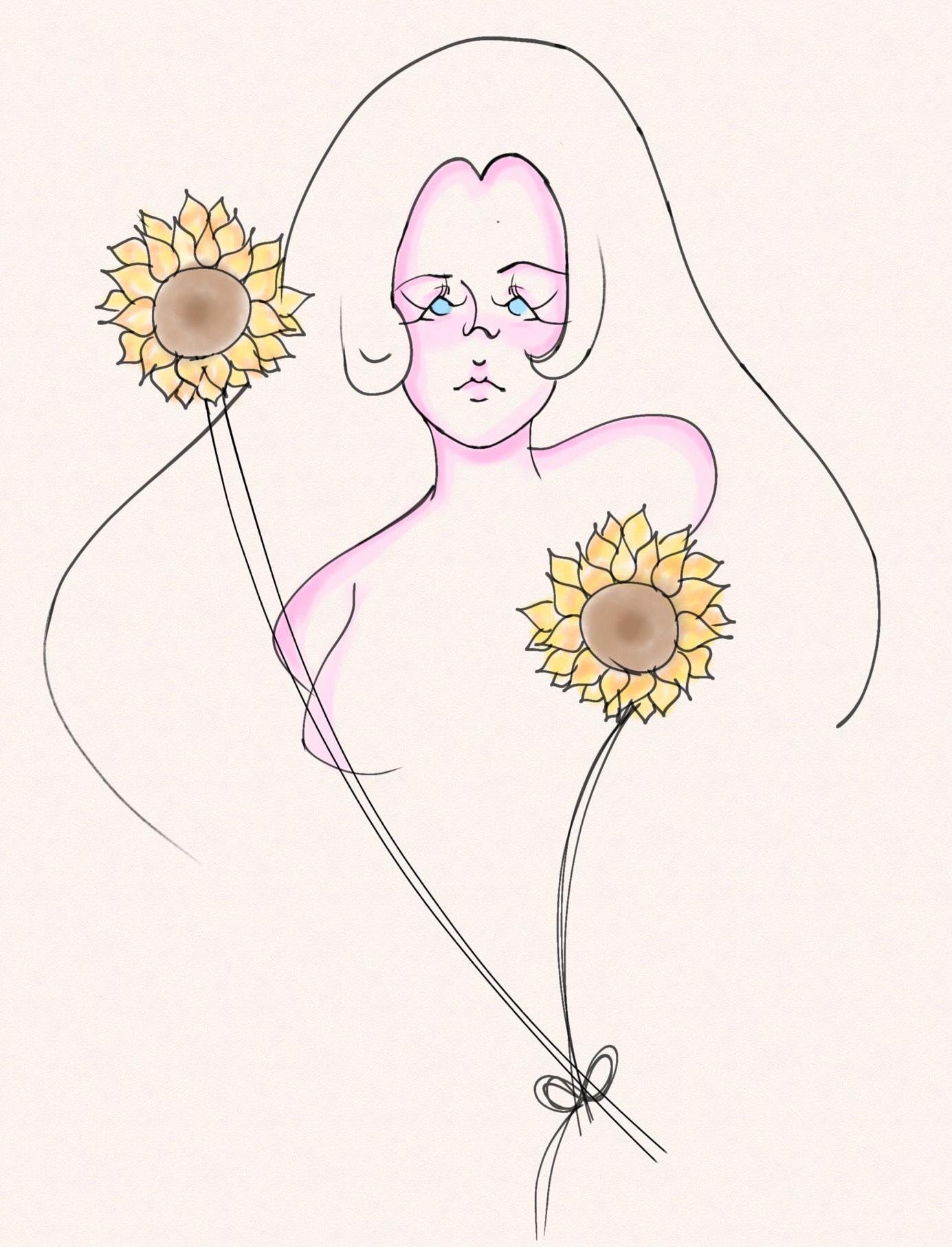
Glitch
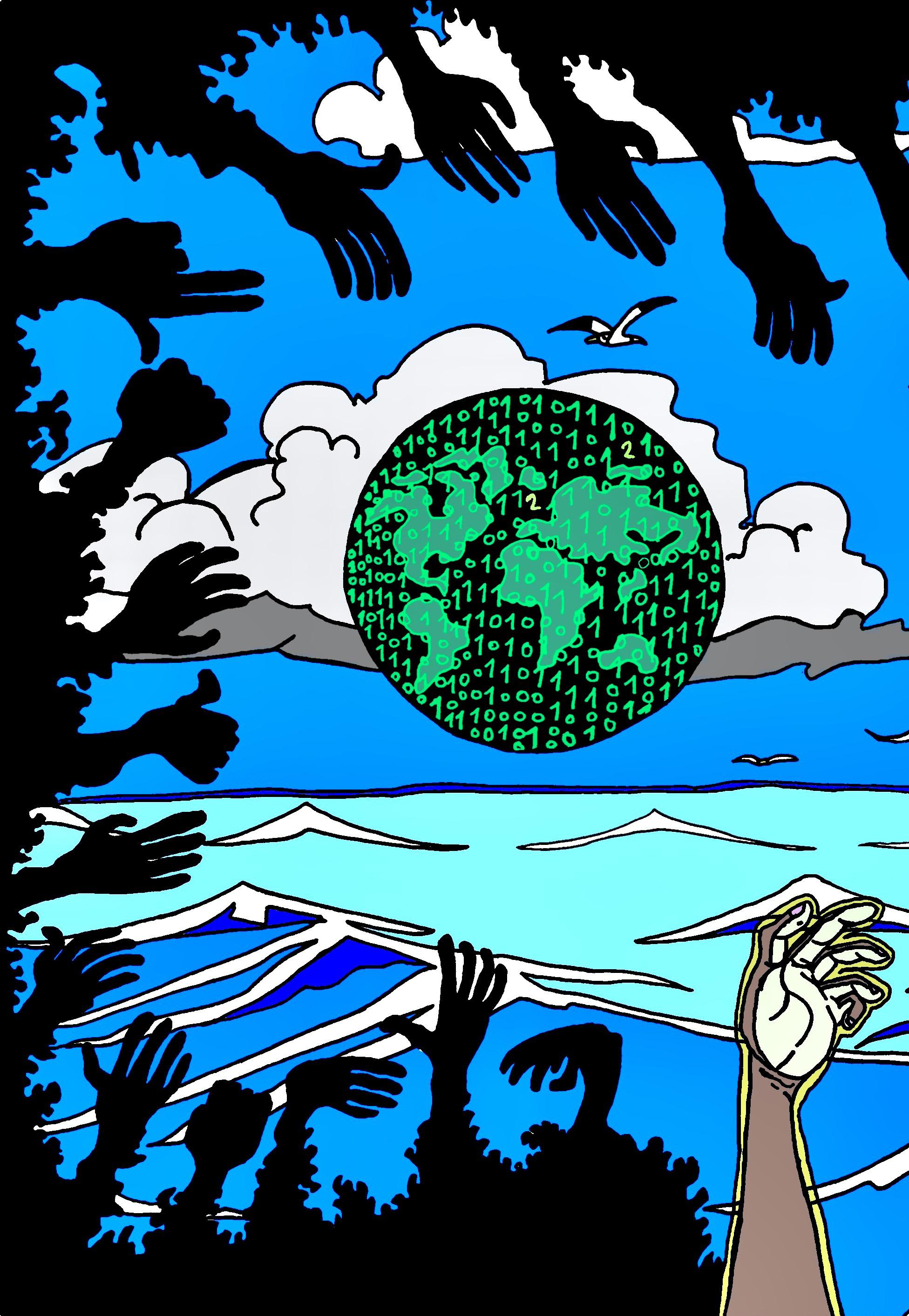
The art is inspired by a really vivid dream I had. Reality is a funny thing, there’s only one, but all 7 billion people in the world perceive it in their own way.
BY STEPHANE FALEU

There’s no right or wrong way to live. No need to work for the system. If you could live in another, would you? And why? Am here to disrupt your mindset.

God is Watching
Inspired by a dream, this artwork shows The Devil wanting to take God’s throne. However, God is not worried and he’s smiling, always showing love and he’s got the most dangerous army with him. Behind him, the dragon looks peaceful, but it’s still a dangerous dragon (just like God is dangerous even when smil-
It’s The Devil’s world, as much as we don’t want it to be. Most people in this modern age don’t believe in God and even if they do, they don’t live for him. I think that today’s society has made it harder to live for God. This work wants to encourage trust in God now we’re in the world.
Shushi World
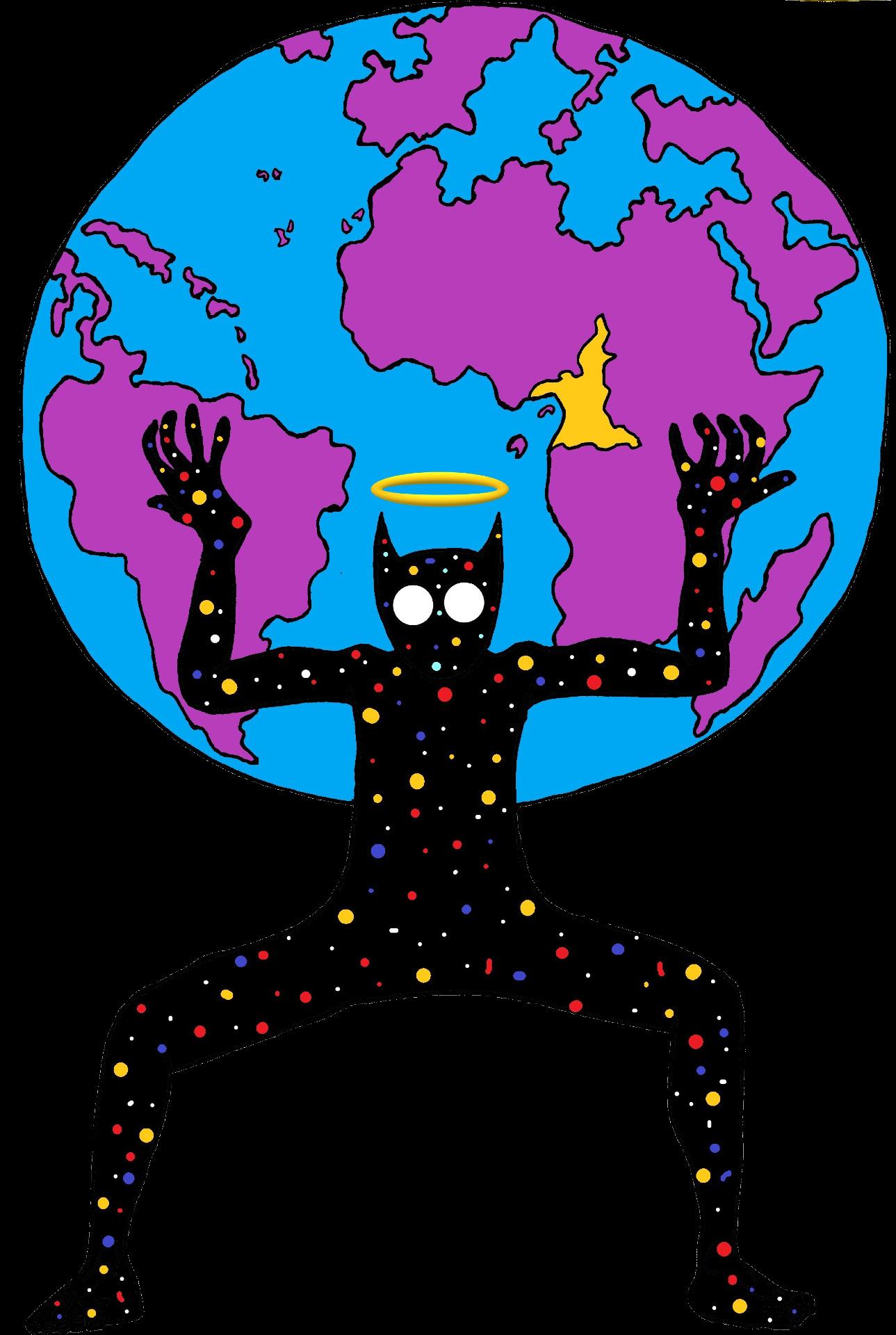
The Sound of Resistance: An Interview with Kapil Seshasayee
INTERVIEW
PHOTOGRAPHY
BY MALCOLM KYEYUNE
BY
SEAN PATRICK CAMPBELL
In September 2023, NPN spoke with Glaswegian protest musician Kapil Seshasayee. Kapil is a multi-instrumentalist whose music fuses multiple genres; ranging from Indian Classical music, R&B, Hip Hop to Hyperpop. His music straddles two extremes; it’s melodic and energetic, the kind of music you can’t help but dance to, but a closer listen reveals the heavy and important topics he is singing about. We discussed the origins of Kapil’s interest in music, his thoughts on the Scottish music scene, and the reason why he is so adamant about uncovering the hypocrisy of the caste system in Indian and Brown communities despite significant pushback.

Music should be whatever it's going to be, but never oppressive.
Who or what inspired you to pursue a career in music and who has been the most important influence on your musical life and career?
I come from a musical family. My cousins were Indian Classical singers, and as a child I would listen to them practising at home or performing in temples. Although I didn’t fully understand what they were doing, I knew I wanted to do something similar when I grew up. The Indian Classical music influence in my work is very much indebted to [my family]. In terms of musical influences, my first album was influenced by Experimental Rock and Industrial Rock music. The second album was influenced by late 90s and early 2000s RnB, and albums like Solange’s A Seat at the Table, Frank Ocean’s Blonde and more recently, D’Angelo’s Black Messiah. I was also influenced by Hyperpop producers like Arca and Sophie. There was a Scottish Indie-Pop band called The Spook School who became quite big in Scotland when I was at university. I once saw them perform live and was inspired by their music; political songs about trans liberation, self acceptance and self love. It
made me question what kind of music I wanted to make, what my songs were about, and how I can engage with my community through my music. That’s when I started writing songs about nationalism, the Indian caste system and disability rights – the sort of topics I care about.
Your two albums A Sacred Bore and Laal are very different in style. Can you tell me about your creative process? How do you approach a new song or album?
You know how the Black community has Afro-futurism? For a long time, I’ve been thinking about what South Asian futurism is and sounds like. For the last 5 years, I’ve been working on what I call a Desi-futurism trilogy of albums. So far I have released two albums: A Sacred Bore about the caste system, and Laal about Bollywood. I’m currently working on the final album. When approaching a new album, I begin with a narrative or story and I then figure out how I can tell that story in 10 songs. I tend to think
I wanted Laal to be the kind of album you revisit
of every song in the album as a chapter in that narrative/story, each chapter building to form an argument. So with the caste system in my album A Sacred Bore, I wanted to emphasise that it’s a very barbaric and outdated form of oppression and social hierarchy and that we should stop adhering to it in Brown communities. Each song therefore contributes towards this argument. I like to do this musically as much as I do lyrically. For example; when you listen to Laal, the key the last song ends in is also the key the first song is in so it loops back perfectly. I wanted it to be the kind of album you revisit.
What do you do outside of music that provides inspiration for your music?
I try to engage directly with the communities I sing about in my music. There is a community of Indians and South Asians who are at the very lowest stratum of the caste system, they are often referred to as the untouchables or Dalits. These are the most oppressed in Indian society. I’ve been trying to learn more
about the caste system and the issues they face because of it by attending community discussions and panels. However, as a caste-privileged person, it’s not about taking up space, it’s more about amplifying their voices. I approach this in a journalistic way. I’m not writing songs about being oppressed, I am writing songs calling out these issues. For example, in April (2023) during Dalit History Month, I made 30 second mini documentaries celebrating Dalit figures on Instagram and Tiktok. This is something I have now expanded to include unknown yet remarkable Indian people such as writers and artists. I am also very engaged in community projects in London since that’s where the largest Dalit communities are.
You describe your work as “protest music”. What does this term/genre mean to you?
To me, “protest music” is a song platforming or challenging a popular narrative; it’s a song platforming an issue which needs to be talked about but isn’t being talked about.
The song Rupture of the Wheel on my album Laal, talks about a wheelchair user being assaulted for not standing up during the national anthem, but he is in a wheelchair and therefore cannot stand up. With that song, I’m trying to start a conversation. I’m questioning nationalist movements in India, in Scotland or wherever, which claim to be inclusive but they aren’t, especially of disabled people.
Do you think all art should serve a higher purpose?
I find the idea that all music should serve a higher purpose a bit miserable. I think we also need light hearted music, a bit of levity. Some music is just big, happy and dumb. Music should be whatever it’s going to be, but never oppressive.
It's an interesting and rapidly changing time in Scotland, so I am excited, hopeful and encouraged by the changes happening.
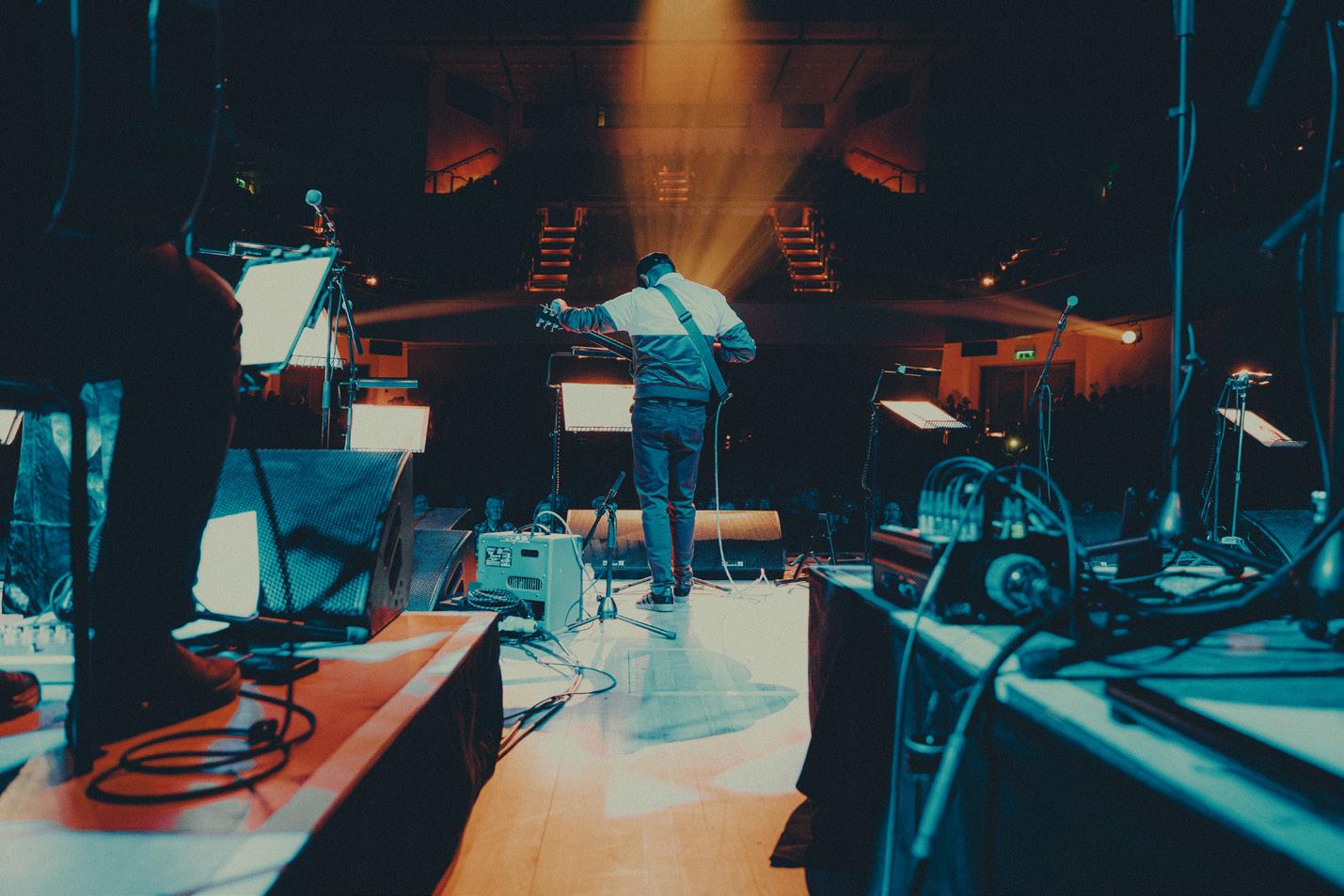
How would you describe the protest or socially conscious music scene in Scotland/ the UK? Does it exist?
That’s a difficult question to answer. There’s a really cool Punk scene in Dundee and some political bands in Scotland who have done some really cool stuff. However, the whiteness of the scene makes it seem exclusive at times. Although measures are being taken to correct this, it’s challenging and slow. When I think of my favourite Black and Brown musicians in Scotland, the running theme is that either no one seems to ever have heard of them or they need to travel out of Scotland to find success and get their big break. Similarly I got my big break in London at a Punk festival for People of Colour. A good example [of protest/socially conscious music] is the band Young Fathers. They are often thought of as a famous Scottish band, but in reality, they had to go to London to get big. They went to London, won the Mercury Music prize, got signed to Anticon – an American Hip-Hop label and then people in Scotland started claiming them. They had to leave Scotland to find success.
Why do you think artists have to leave Scotland to get recognition, what do you think is broken in the system in Scotland?
In my opinion a lot of music that comes out of Scotland fits into one of four categories: Traditional music/ceilidh-adjacent music, Indie/Sad Post-Rock music, Transmit-landfill Indie and then the big production Pop sound which every country has a version of. If your music doesn’t fit into any of those categories, you will struggle to find a following in Scotland. So if you have to pick what’s broken, it’s that people in Scotland have been shown these four kinds of music for a long time, so they gravitate to it. A lot of audiences, especially in Scotland, find it alienating if an artist doesn’t fit into those categories, because they want to know what they are going to get. If you only show people four kinds of music for a long time, they will only be expecting that. I’ve seen many attempts since 2020 to change this by adding more diverse artists to bills, but there’s definitely a pushback, with reports of more diverse festivals not selling well in Scotland. It’s an interesting and rapidly changing time in Scotland, so I am excited, hopeful
and encouraged by the changes happening.
Your music often references news and stories occurring abroad in India. Do you feel your music has helped bridge the gap for the Indian diaspora?
I think a lot of Indian diaspora music tends to be quite surface level. Even when it’s political, it’s not inward looking. For example, it doesn’t ask questions like, “Hey, why are your parents voting for this right wing politician back in India? Or why is your uncle homophobic?” I’m looking more inward than my community [the Indian community] is comfortable with, so I’m labelled as controversial. On the other hand, it’s brought the community closer. For example I found a lot of recognition on tour from the
Indian community in Canada from singing about an honour killing which occurred in British Columbia, Canada. That’s the song titled The Ballad of Bant Singh on my first album A
I have had a lot of people say horrible stuff online, but either way, the conversation is being had.
Sacred Bore. I have had a lot of people say horrible stuff online, but either way, the conversation is being had. The people who come to my shows are very into my music and these issues. They are supportive and I am very grateful for them.
You can find Kapil’s music on all music streaming platforms. Keep up with him and his work on Instagram, TikTok and Youtube
@Kapilseshasayee where he also makes mini documentaries about influential figures in Dalit and Indian history.
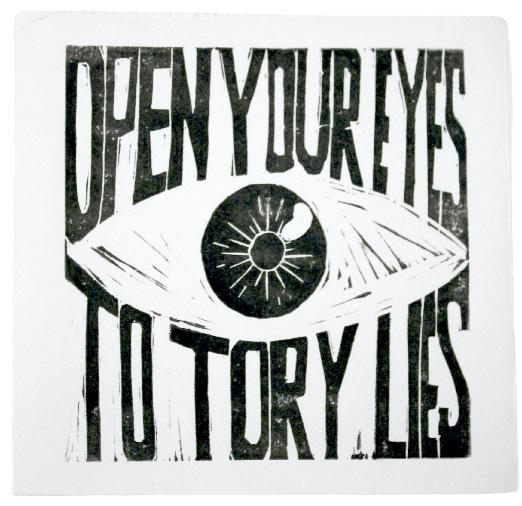
ARTWORK BY NIMAI VARIA
Under the stars
Invisible yet Visible Monster
BY SHAMISO ZVANDASARA
Hiding the plain sight of white silk bed covers
Behind the lonely wee castle gates
Feeling invisible like the mist of the day
There is a monster in my body
Unseen Clinging Halting every dream milestones
Un-detectable bones
The Microscope cannot find a volcano
With no trace
They have no answer
I am invisible outside
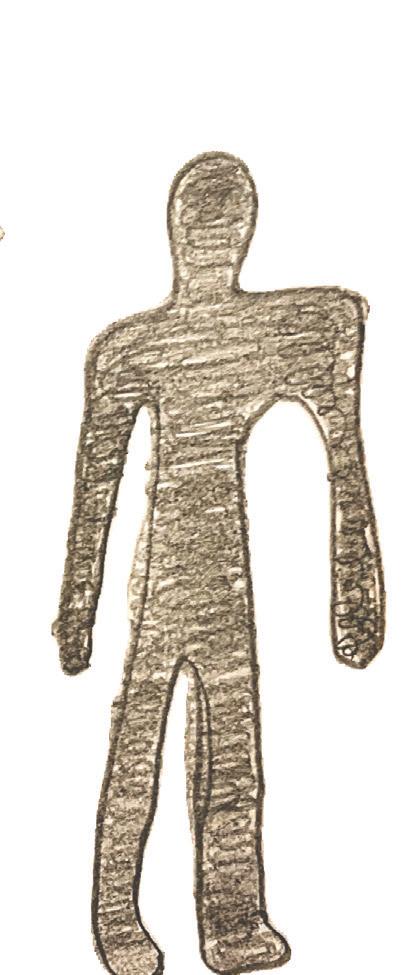
Visible when the cold bathroom floor is a friend
Every second of the day, I envy other girls, who decorate their black fluffy afro-crowns with white daisies,
Writing beautiful stories with their dashing prince.
Girls don’t cry, Imagining pain, Has become my second name, Everyone dismisses the volcano fire
A vulnerable person
Fights with a sword everyday Wee cry baby, Is what they call a lady who has been

This invisible disease
Has no name
Dissolving buttons of painkillers before noon,
Warrior Is the crown I wear
Under the glazing sunshine
Invisible yet visible
Unseen, unknown it has no limits
A brave Heather Refuse to be defeated
When the sight of an invisible Loch Monster appears every month, With no end.
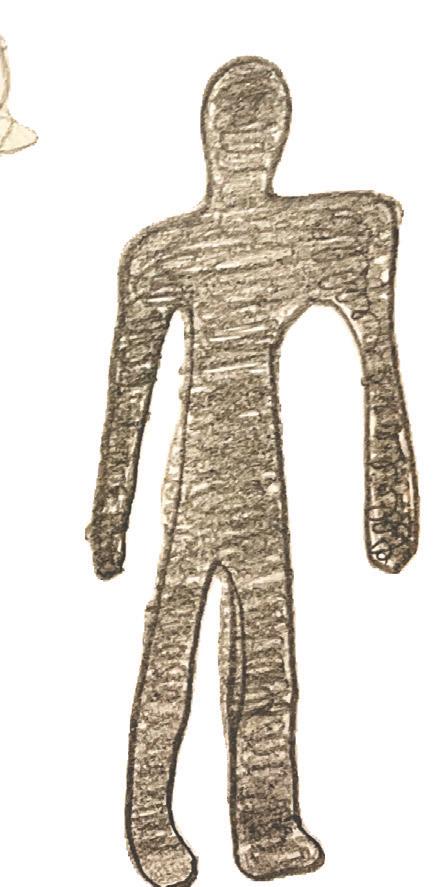
If Loving You Is Wrong, I Don't Want To Be Right: an examination of illegal Black queer love in the film Rafiki (2018)
WORDS BY MURATIWA.
ARTWORK BY MALINI CHAKRABARTY.

The film Rafiki (2018), directed by Wanuri Kahiu, is an engaging examination of love and social conventions. It defies expectations by showing a same-sex romance in a traditional Kenyan setting. The movie follows the love story between two young Kenyan women, Kena and Ziki, whose fathers are political rivals. As their love for each other grows, so does the pressure of upholding their family and societal image intensifies, and so they have to keep their intimacy hidden. However, as gossip spreads the townsfolk attack Kena and Ziki causing them to be arrested
and separated. Nevertheless, true love prevails as they reunite years later concluding the film on an uplifting note. The film breaks down social taboos and explores the hardships LGBTQ+ people endure, provoking discussions on cultural norms and the ability of love to challenge and transcend them. Despite the difficulties the film encountered—including a brief ban in Kenya because of its LGBTQ+ themes—its perseverance in the face of hardship further heightens the film’s appeal. The film proves art’s disruptive value, as it points the way towards a more inclusive future and acts like a mirror exposing society’s imperfections.
I came across this film halfway through my first semester of film studies. It was the first time in an academic setting where I was introduced to Queer Theory and “international” films. It did not sit right with me, as many of my lecturers and tutors discussed this film in the context of decolonising the syllabus. I thought that diversity would be a given, but instead there was only one week per semester dedicated to studying intersectional films. This class opened the discourse of scrutiny against its narrative and visuals, as many of my classmates felt it did not live up to the other mainstream Eurocentric content. They thought the narrative was unrelatable because of its ambiguous ending, but we could all agree that it was visually beautiful, colourful and engaging in regard to exploring what being queer in Africa means. I felt exhausted during the many heated discussions I had with the tiny people on my screen due to COVID restrictions that week. Exhausted by having to continuously explain and advocate for what it was like being a Black queer African woman. That week, it truly felt like I opened my eyes for the first time. Even though most of the time was spent in an isolated bubble, this event had removed my rose-tinted glasses of living in a new country. Still, with a new outlook on life, I realised I was the walking case study that my classmates, tutors and acquaintances could dissect for any gritty racial debates. Therefore, this film is significant for me as it reminded me of my home, but also the reasons why I moved so far away from it.
As a young girl living in Zimbabwe, the stories constantly portrayed in books, film and television never felt relatable. It made my adolescent years confusing and frustrating as I thought the experiences reflected on the screen did not seem possible. I was constantly told “I am pretty for a Black girl”, but never pursued romantically; friendships were complicated to form due to segregation and family politics, and the activities and hobbies that I loved were constantly questioned and ridiculed with the threat to take away my “Black card”. Rafiki serves as a powerful source of inspiration, not only due to its captivating narrative and the talent of its female African director, Wanuri Kahiu, but also for its trailblazing impact in challenging and overcoming the Kenyan anti-LGBTQ+ legislation through a landmark Supreme Court case. In addition to depicting the whirlwind of new and forbidden love, the film instills hope within me. As I navigate through countless lectures and seminars discussing the underrepresentation of marginalised directors and writers, Rafiki stands as a testament to the belief that change is possible when one possesses a compelling story to tell. It encourages me to persist in my journey of seeking my own kindred spirit, whether that be in the form of a person or through my own artistic expressions.
Nowadays, the scenes of Rafiki are always on my mind. I find solace in the scenes of Ziki braiding Kena’s hair as an exchange of affection between the two in contrast to the many strangers that walk around picking at my locs like vultures to a dead carcass. The film unfolds, a mirror so clear, indirectly reflecting the battles of many immigrants in this foreign land. The dialogue between Ziki and Kena surrounding their future reflects the constant struggle between upholding tradition and gender expectations versus the newfound freedom rarely discussed in the media. This realistic and natural portrayal of their discussion around their future, especially Kena’s future, should be praised. Kena fears that her aspiration of studying medicine is unacceptable due to gender roles, but the film concludes with Kena becoming a doctor. This positive illustration of a queer character with agency
contrasts with the role of women of colour in other genres like the slasher film or early 90s Rom-Coms where women of colour are side characters with underdeveloped storylines who may not even make it to the end of the film. Thus, this film is a refreshing departure from the stereotypical narratives as the film’s ending is hopeful on the note of freedom of gender expectations and reunion of Ziki and Kena.
Ultimately, Rafiki emerges as a cinematic revolution, a disruptor of silence, a voice for the voiceless, and a testament to the power of storytelling. It weaves a narrative that resonates deeply, creating a sense of unity and empowerment in the face of adversity. It serves as a reminder that the Eurocentric coming-of-age (queer) story is not universal, especially in a society that may not always celebrate diverse expressions of love. Rafiki unapologetically portrays the beauty and challenges of same-sex relationships within Africa. Therefore, it is a highly recommended watch due to its compelling narrative and authentic representation against conservative societal expectations.

Out of Water is a series of images I’ve created. The images are intended to represent the ongoing misconception that Black women cannot express themselves as soft, free and feminine – a privilege that is most often exclusively afforded to white women.
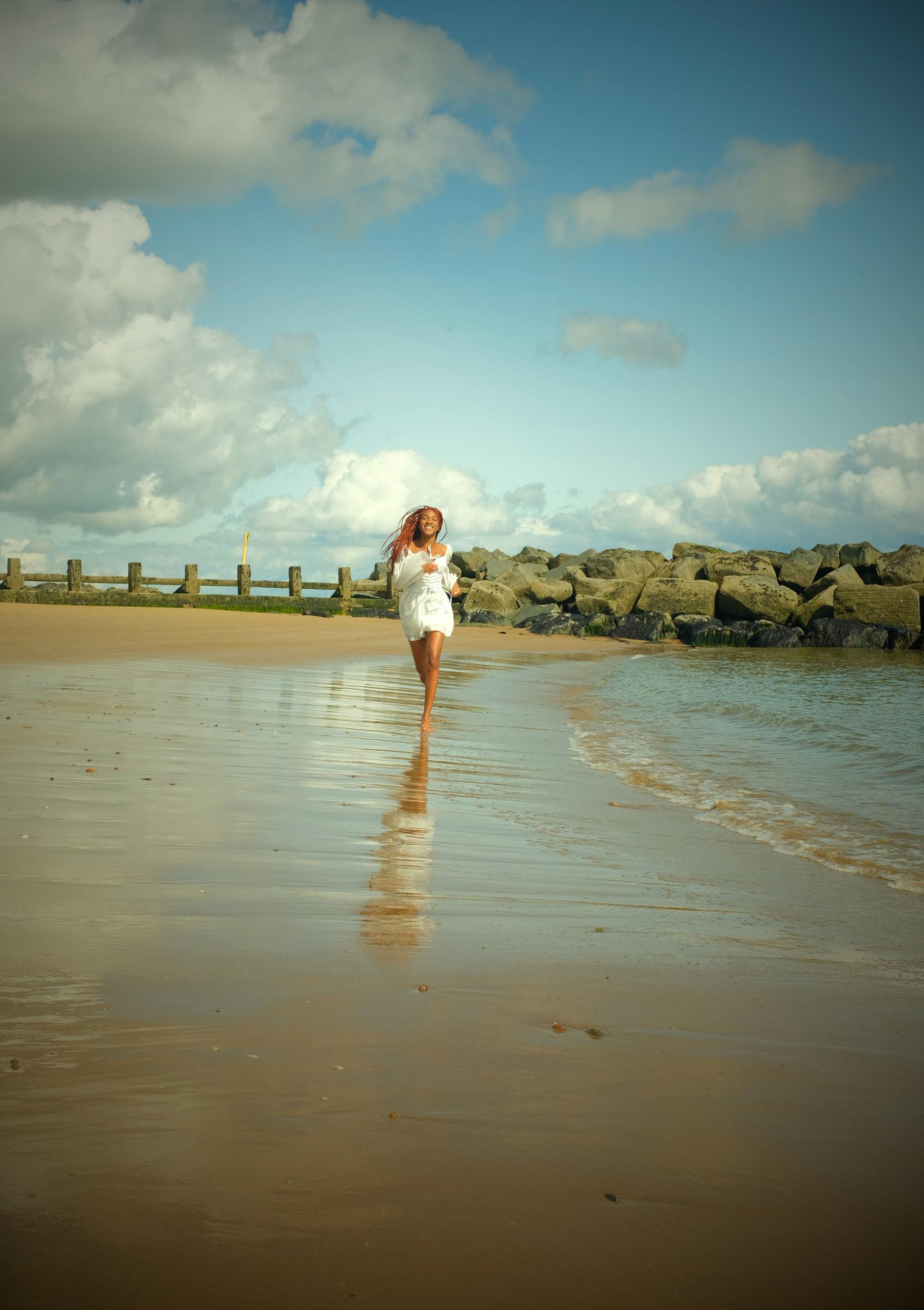
Out Of Water
ARTWORK AND WORDS BY LEAH FLINT
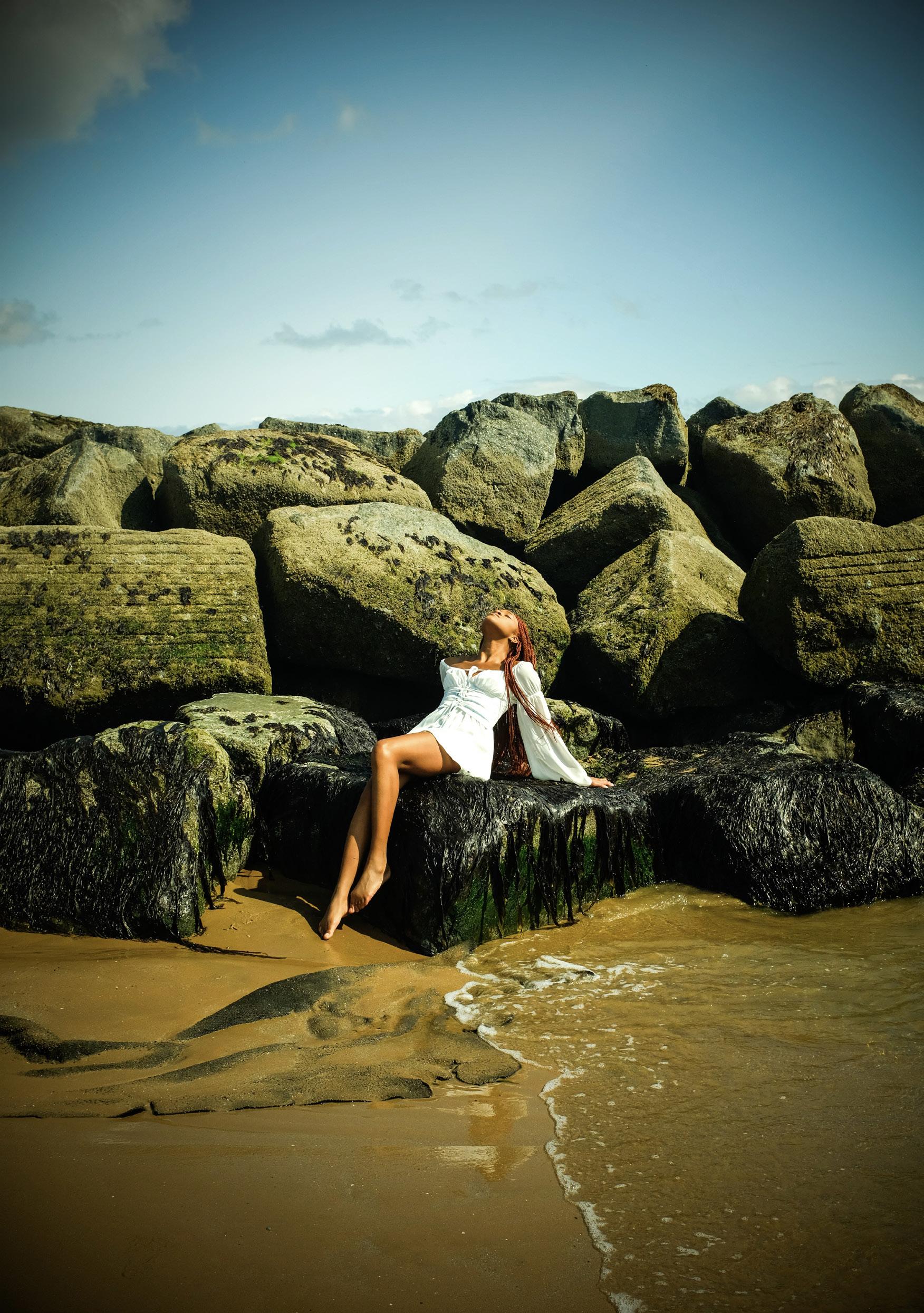
Black women are often depicted by the media as abrasive, hard to deal with, and angry. However, I know this to be untrue. The Black women around me are always gentle; whether it is in the way they cook, the way they manage my hair, or the way they make me feel and laugh. There is much more to Black women than our depicted image(s).
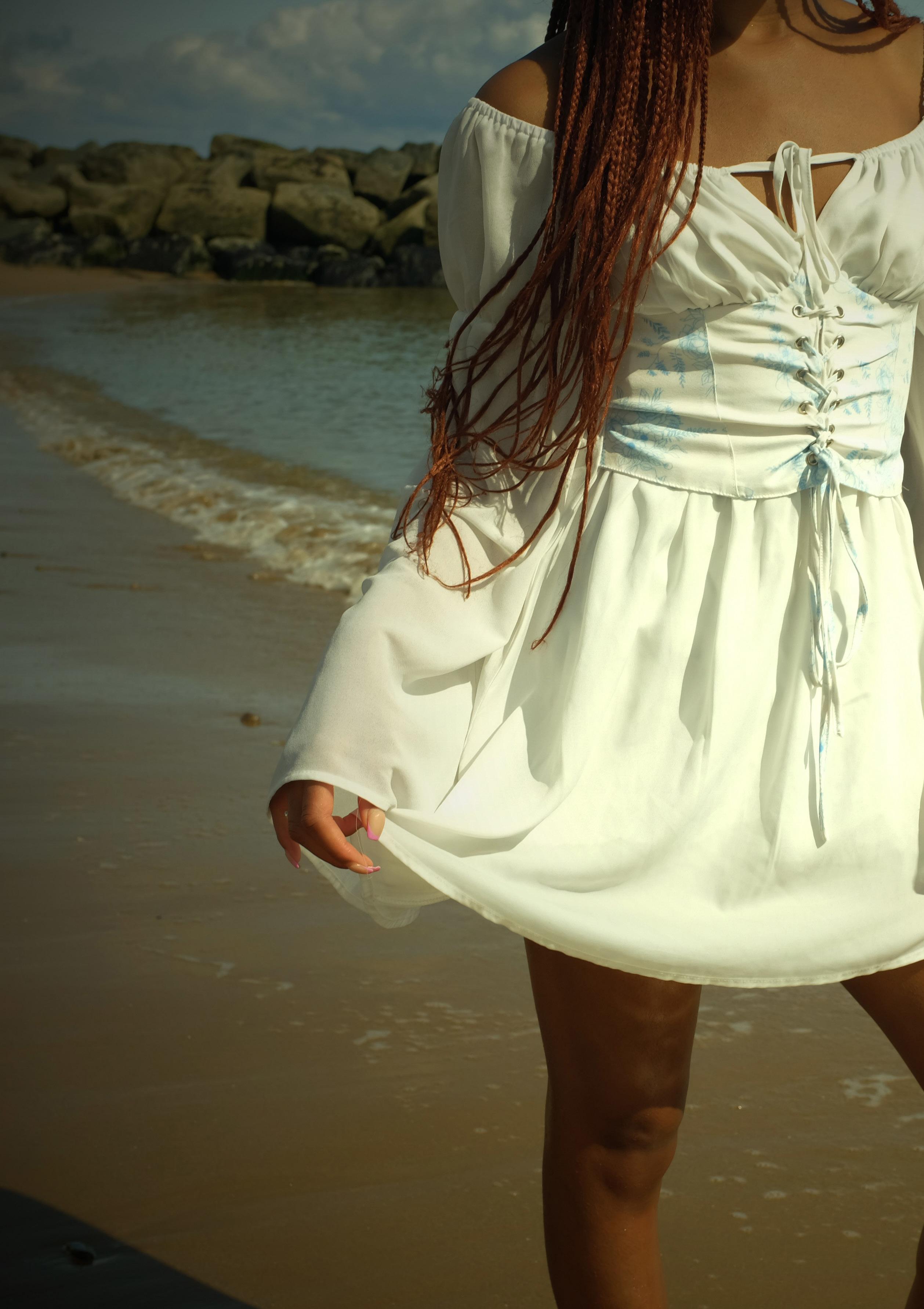
With Out of Water, I challenge the very notion of ‘the art of disruption’, by showcasing that Black women do not need to be disruptive in order to be represented. Black women’s behaviour is over-politicised. I wanted to show that we can just be, in our authentic fullness, without considering the wider “ramifications” of our actions.
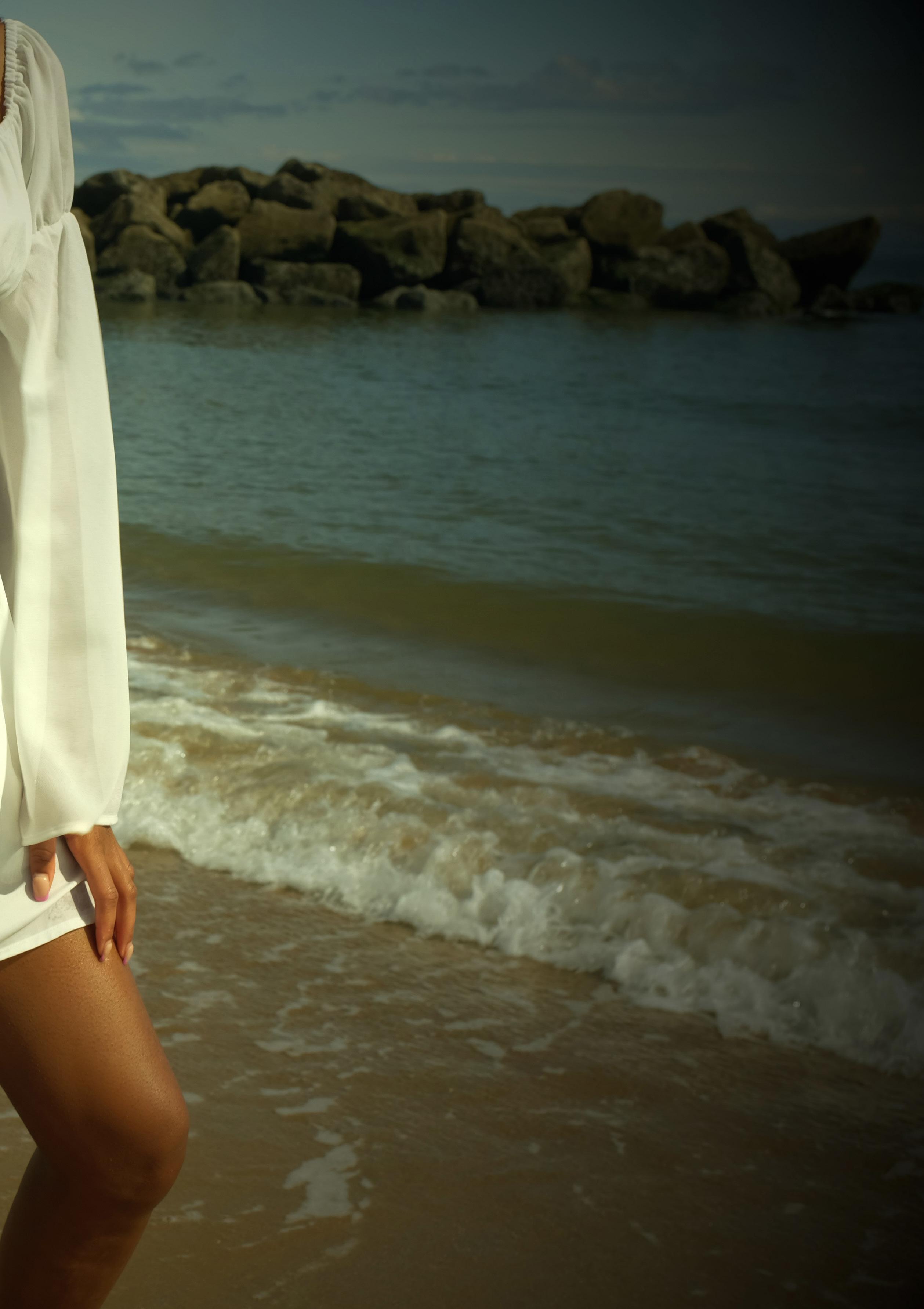
This desire was inspired by Nella Larsen’s novel Passing. In Larsen’s novel, Irene, a timid, introverted Black woman, who is jealous of her lighter and more extroverted friend, Clare, realises that she does not need to uphold false narratives of herself in order to be recognised: “I had only to break it, and I was rid of it forever”.
I wanted to implement this sense of freedom in Out of Water by showcasing my beautiful model in a white dress, signalling to the divinity and virtue of Black women.

The playful and youthful energy presented in my images were visually influenced by the The Little Mermaid live-action film. I juxtapose the rocks that surround the model (which represent the embedded structures built against Black women, that infiltrate our daily lives) against delicate, soft lighting to show that Black women can – and should – be vulnerable, protected and uplifted.

All in all, I hope Out of Water contributes to the multifaceted position that Black and POC women can occupy.
Sound Up! Scottish Highlights
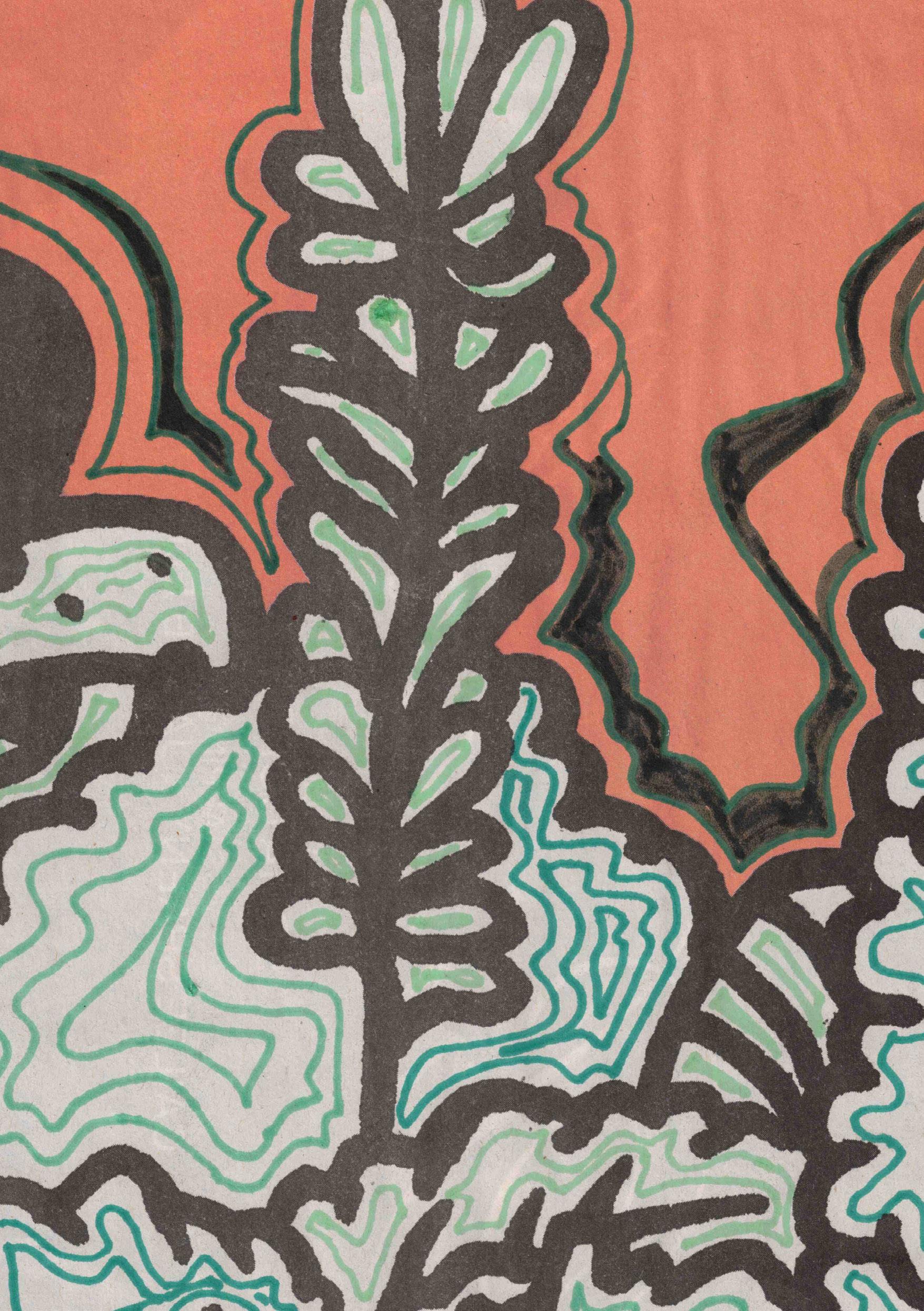
NPN had the pleasure of chatting with Ace V!s!on, Rue Cooper and Supermann on Da Beat. Three artists in Scotland who have many exciting music projects ahead. Read on and dig into their music!
ACE V!S!ON
ACE V!S!ON (they/he) is a Scottish-Malawian poet and active rapper/musician who is equally as comfortable communicating freestyle/spoken word on open-mic stages as they are lacing eloquent rhyme with experimental rhythms, often inspired by themes of grief, loss and the universal human condition.
What drives your art? Learning, I’m obsessed with learning: new things, irrelevant things, useless things… just constantly taking in new information and finding ways to output that. My art comes from mashing and conglomerating and constructing ideas.
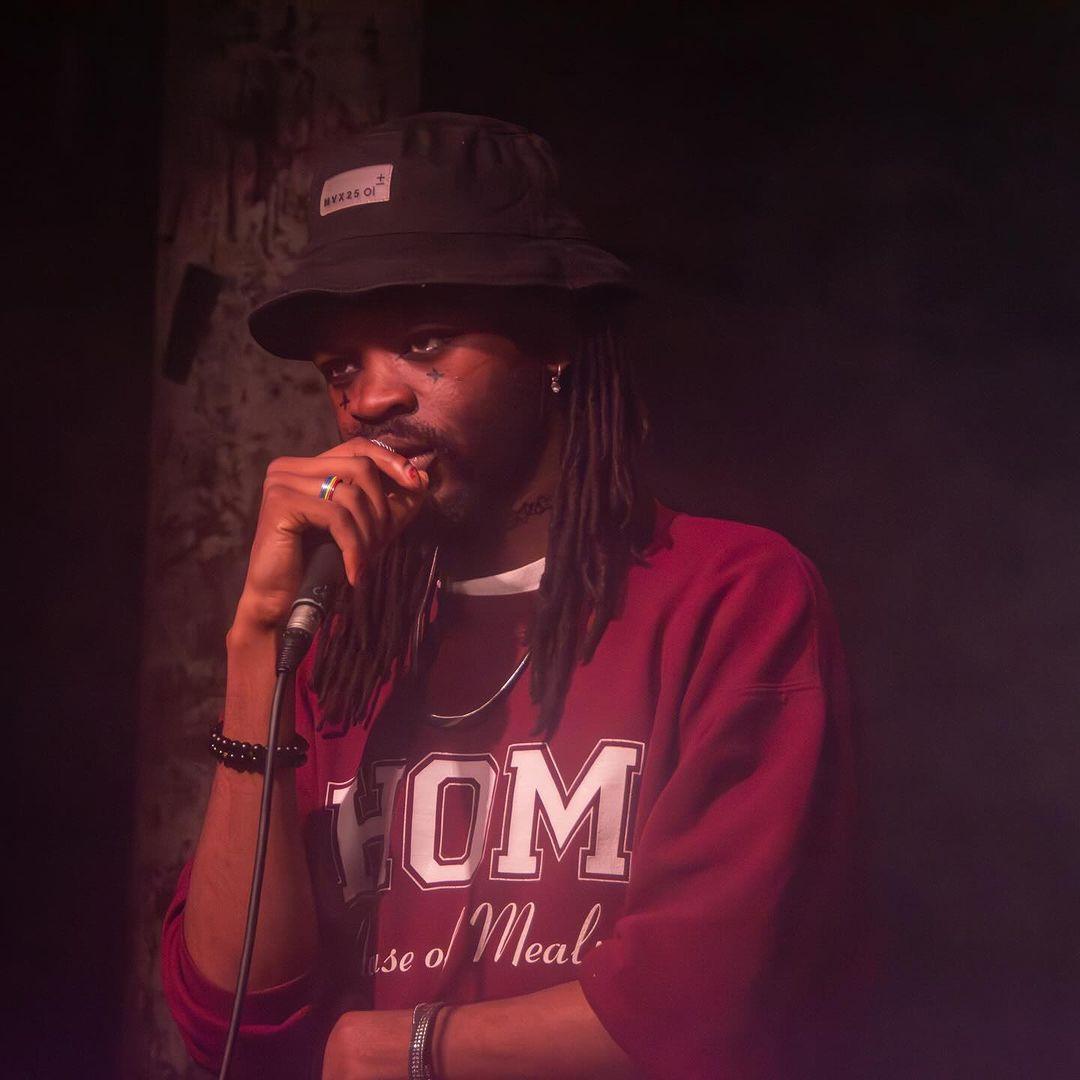
I think that’s why my art is multidisciplinary: poetry, music, acting, teaching, etc.
Something you consider disruptive: Recently I’ve been in love with the idea of non-conformity, breaking the flow of things even for the sake of it, without having to have a reason or cause behind, just understanding the power and the sparks that can be created from going against the grain. Doesn’t matter if it’s not new, it can also be old: reclaim a sense of the past, old ideas and methods. I also like the idea of discomfort these days: pick something and put it in an environment that it’s not used to surviving in and see what comes from that.
Recent obsession/favourite: The Fire Next Time by James Baldwin, it’s letters he gave to his nephew and as I recently became an uncle, Baldwin really puts into words a lot of the feelings I’ve been feeling. He describes the relationship to this kid and seeing the physical features of the father in the kids’ features. The timing of reading this book and this life experience have been really special… I’m obsessed with it.
Recent dislike/hate: It’s not as deep, but I love anime and I’ve recently started watching Dragon Ball Super (I grew up on the old Dragon Ball Z) but [Dragon Ball Super] is not living up to my childhood nostalgia expectations. It’s just not the same. The sense of immersion isn’t there, and maybe that’s because it’s not made for me anymore.
Your most disruptive art you have created: I feel like that’s a question I would like to ask to the people that have interacted with my art because often I don’t go into creating with the intent to disrupt (although I love when it does disrupt and this disrupts me as an artist). Maybe my approach to artmaking is more disruptive than a singular piece of art: despite everything I do as a musician and rapper I’ve never released anything on streaming and that’s a small disruption in a scene where everything is
about “release, release, release”, “get your streams up and your numbers up!” and that’s the only path. I just do what I love at my own pace and time and for now, hold full ownership of my “children”, my creative pieces. I have this weird monopoly over my stuff: you can’t see what I do unless you come see me live in person and even then, it’s different every time, it’s fleeting – you hold on to it for a moment and then it’s gone again until the next time. Not that I’m against [uploading songs for streaming] but right now I’m very protective of my art.
Your favourite reaction/review of your work: People are really nice, it’s always really lovely stuff to hear. Somebody once described what I do as leaving breadcrumbs, a trail to follow and then it’s up to you to interact and pick up these pieces and put them together or choose to go on a different direction, take your time with it… I like that analogy, I give you these breadcrumbs and you can choose to come along the journey and find out, or not.
An ever-present theme in your art: Conflict or constant juxtaposition of conflicting ideas, usually dark/light, good/bad, joy/ sadness… Some of my more vibey happy stuff have elements of remorse or melancholy, giving that shade to the light and then in my darker, heavier stuff there’s always this theme of “I wanna give up but for some reason I can’t because there is still a striving force”. Typically opposites, playing with a duality or plurality is an ever-present theme.
Name an icon: Meshell Ndegeocello. They’re a musician, poet, bassist, speaker, lover, artist, writer… everything I aspire to be.
Keep up with Ace and their upcoming projects on Instagram: @blackmanbegins
Supermann on da Beat
Supermann on da beat, aka Sanjeev Mann (he/him), is a Scottish disabled South Asian music producer, activist and poet who blends genres from hip-hop, metal, and pop, to create unique tracks without borders. Supermann is also an A&R at Imvaizemusicgroup, and runs Hip Hop Scotland – a platform supporting hip-hop influenced artists in Scotland. Supermann is proud to illustrate that anything is possible, even in a world where disabled artists are underrepresented. He recently led a campaign asking the UK Government to provide funding to make venues fully accessible.
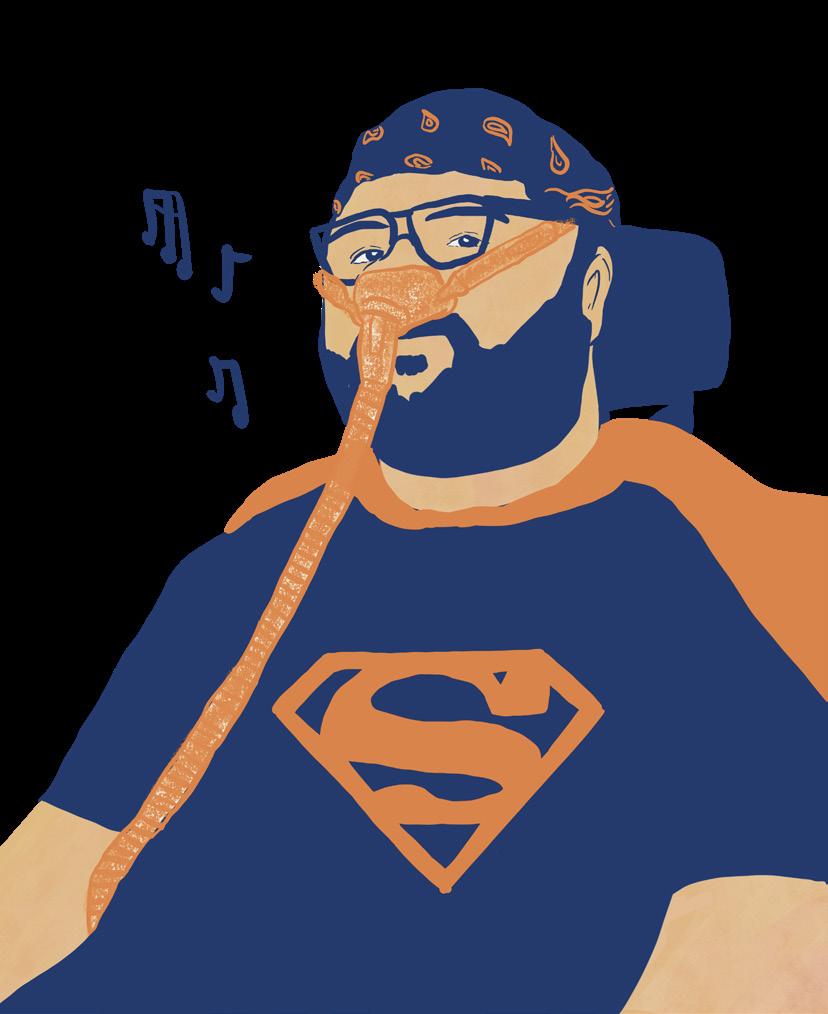
You are a person of many talents, including, but not limited to music. What or who inspired you to make music? For me music was something that I always wanted to try. The fact that music can bring people together is what drew me to it. I don’t have formal training in music, but I think this can be an advantage which means I am not closed to new ideas. Music is also similar to journalism which is my back-
ground, and there’s quite a lot of transferable skills. I think [music] is also similar in ethos [to journalism] in terms of questioning and speaking about issues we face. It’s a running theme throughout my work; I just want to get my story across while trying to connect with people and show what is possible. In this case I do it through creating music.
How would you describe the music that you create? It’s hard to describe. I would say it’s alternative hip-hop with elements of trap, grunge, old school hip-hop and pop. I’m heavily influenced by metal as well as punk, and of course most styles of hip-hop. Once you throw it all together, it sounds more like pop and trap. It’s quite hard to put a label on it because it’s so diverse. It’s more like a free flow of energy and emotion.
You are a creator, writer, journalist, and so many other things. Is there anything else that you want to try next? I’ve done a lot of different things and they are always a part of me, but I feel that music is my true purpose. I’m so blessed to have found it, because so many of us don’t [find our purposes]. Going forward, music will be my main focus as well as disability activism – trying to fight for work and disability rights issues. My activism can take many forms such as performing through music or public speaking. I also run a platform called @hiphop.scotland. Hiphop Scotland is a platform that supports local artists through regular live shows, podcast episodes, playlists, and reviews. Again, I feel so fortunate because through this I’m able to combine everything into one. I love working with and bringing together people from different backgrounds that you might not expect. It’s all about connecting with people who have different perspectives to allow us to open our eyes to other peoples’ experiences.
What is your interpretation of the Art of Disruption? I would say PUNK. It’s a music genre, but also a subculture that includes a diverse and wide array of ideologies and other forms of expression, including visual art, dance, and film. I think the ethos of hip-hop
is also similar. Both genres and cultures talk a lot about social issues. Sometimes though I feel it’s not enough and we need to take more direct action. There needs to be more awareness in the general public about social issues, and more specifically issues facing disabled people. This is what inspired my upcoming spoken word project. I want my music and message to bridge that gap. I think it is important for people from different backgrounds to connect with each other. We need to bridge the gap by bringing these issues to a mainstream audience to really push change.
Tell us something about your spoken word project BREATHE. Breathe is a step ahead of what I usually do around music. In the past I’ve mostly produced music for other artists, but I felt that it was the right time to release my own project sharing my story while raising awareness. I’d never done spoken word or recorded vocals before so it was confronting, but fun! I like to challenge myself. This piece and the full EP talks about the issues disabled people face in day-to-day life and combines elements of spoken word and rap with punk, grunge, and trap making it a super unique collection of songs. It’s the first time I’m recording myself; I’ve never done anything like this before and I’m excited to see what people think.
Is there a specific message that you want to deliver to those who follow your music? I think a lot of people have an unconscious bias towards something. They have learned assumptions, beliefs, or attitudes that they aren’t necessarily aware of, and this is something I tried to address in my piece, Be You. People have these preconceived notions that are ableist. For example, people subconsciously think that disabled people should be ‘fixed’ but the reality is disability is not, and doesn’t need to be, a bad thing by default. It’s all about perspective. We are not all the same, but that’s the beauty of human life. We’re all on earth for a reason, and the sooner you know this, the better.
We all have a purpose and I want everyone to remember this. It’s sad, but we need to make people more aware that disabled people are capable of doing everything able bodied people can do in their own unique way and in their own capacity. Society should accept us all with no shame. The only way to move forward is by working together collectively.
Keep up with Supermann and his upcoming projects on Instagram and TikTok:

Photograph by Pooja Joshi
Rue Cooper
Rue Cooper (she/her) is a singer and songwriter from Nassau, Bahamas. Now based in Edinburgh, Rue’s love for music was apparent from age 2 when she frequently communicated with her parents through song.Currently Rue is the vocalist and songwriter for Groove Down, an Edinburgh-based disco-soul band whose original music proves that funk lives on, and we’re all part of its beautiful legacy.
What drives your art? I’m a very expressive person, and through my music, I like to communicate feelings and ideas that are universal, but can be difficult to convey. The older I get, the more I realise, oh wow, not everyone’s as emotional as me; not everyone expresses themselves through words like I do. My performances are guided by raw emotion. To me,
INTERVIEW
BY
HAZEL PETERS
PHOTOGRAPHY BY
MARINA BRAW
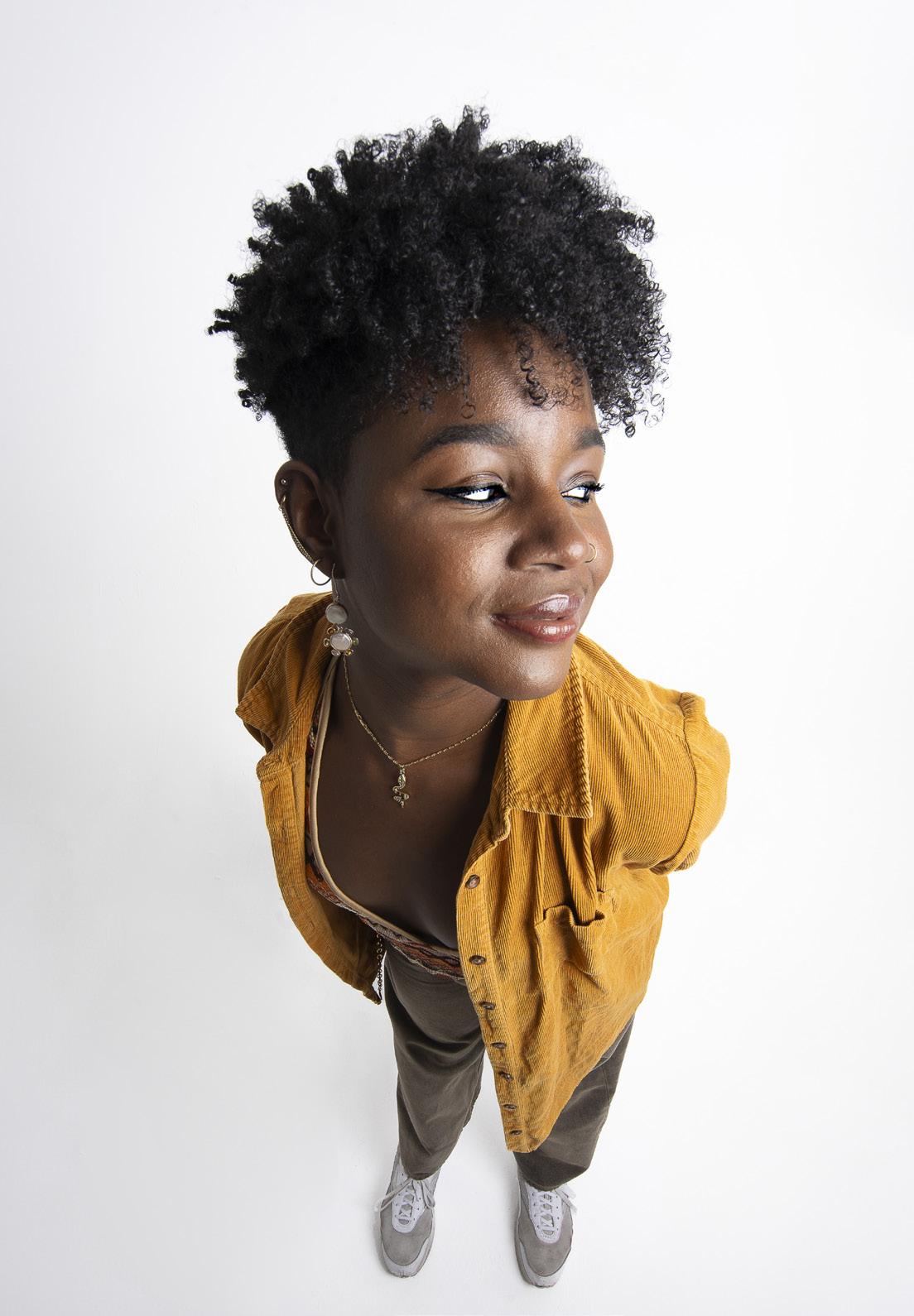
the raw emotion is the truth of any song. Especially as someone who does soul, when you’re belting, when you’re really trying to communicate, it’s not a time to hold back.
What does the word disruption bring to mind? Anything that shakes the status quo. It doesn’t have to be inherently positive or negative – disruption is a force of its own nature. It’s up to us how we channel its message. I specifically think of mental disruption, and thoughts that push us towards change.
Recent obsession/favourite: Game of Thrones. Just seeing what humans do to themselves because of pride, because of greed. It’s interesting to watch because of the psychological analysis that I can do. And the gossip. I like the gossip aspect.
An ever-present theme in your art: I’m all about love, and love in all its manifestations: self love, relationship to self, relationships to others, generational love. I’m fascinated by the concept of love that extends through space and time.
A piece of art that challenged your point of view: The Vanishing Half by Brit Bennet. It challenged my point of view by making me realise not every book by a Black author, especially a Black female author, accomplishes what it sets out to do. The Vanishing Half was beautifully written, but I felt the subject matter and character exploration was shallow. It ended up being a bit of a violent book to me. As a dark skinned Black woman, I don’t mind seeing colorism from a light skinned Black woman’s perspective, and how it’s damaging to her, because I think colorism can be damaging to everyone, but I felt like the book’s takeaway was, oh Black people are jealous of you, and dark skinned people, have some weird fetishisation with you. All that to say, The Vanishing Half made me think about what I require from a book, especially as a Black person reading Black literature. This isn’t a straightforward answer, but honestly, that’s the piece of work that came to mind. I gave it a two stars Goodreads review because it just kind of upset me.
Your favourite reaction/review of your work: I was performing at a Fringe gig, and afterwards this girl who had been going through a rough breakup came up to me, and said, “Seeing you on stage empowered me. Seeing such raw femininity made me feel okay for the first time since I’ve been broken up with.” Her comment made me appreciate the cycle of life in terms of accepting myself and accepting what I feel is my destiny – aka music. I was able to touch someone without even thinking about it, just by doing what I always do.
Something that brings you joy: Reading. I used to be such an avid reader, but going to school and having to read books as part of your degree, took away reading for pleasure. Last year, I read two – three – books max. Now I’m getting back to reading and forcing myself to make it a habit for relaxation. Reading has been bringing me a lot of joy because it’s reminding me of someone that I haven’t been in almost 10 years.
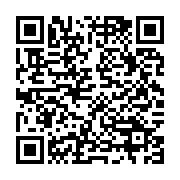
Be You
Society has taught us that there’s something wrong with us that needs to be fixed. This means we’ve never embraced people who are different.
I am human. I am worthy, I don’t want to die. I love my life.
I am not a soup storyline. I am not a red nose day sob story
I am not undateable. I am not a bond villain. I am not an object. I am not a burden. I am not cursed.
I am not special. I am able.
I am not a label.
Our persecution throughout history is a reflection of society’s attitudes. I am the same as you.
I feel my life has been enriched by disability, I wouldn’t be the person I am today without it.
BY SUPERMANN ON DA BEAT
I believe everything happens for a reason, I am glad I found what I am here to do. I feel blessed because many never do.
There’s no point worrying about the past and future, Or what could have been, It’s already happened. Maybe it’s meant to be like this.
Be you.
Chase your dreams.
It's not all gone, There's still time to change, There's always hope.
Enjoy life. We all have limited time here on earth, So make it count, Make every second count.
Q&A with Scotland-based collectives Exhale & Saffron Cherry
Exhale and Saffron Cherry are two collectives fostering community by and for queer People of Colour in Scotland. No Permission Needed sent both groups an email with some questions, and they were generous enough to respond! We spoke with Sarah and Butch from Saffron Cherry, and Mahasin from Exhale.group.
Can you please tell us about your collective and the work that you do?
Saffron Cherry: is a group that creates a safe space for queer and trans people of colour in Edinburgh. We currently run community gatherings and cabarets. The community gatherings are solely for QTPOC (Queer, Trans and People of Colour) where people can come together to share their experiences, participate in cultural exchanges, and build artistic collaborations and a sup-
port system. These gatherings are a safe space for a minority demographic in Edinburgh to build connections. The cabaret, which is open to allies, features QTPOC performers to [showcase] their art to the community in Edinburgh.
Exhale: is a non-profit organisation which aims to create safe space to dream, explore and connect for QTIPoC+ (Queer, Trans and Intersex People of Colour) living in Glasgow and Scotland. We are a small team of Black Scot-
tish/British Queers who have a background in advocacy, community organising, education, and public health, with a passion for social justice, specifically queer and racial justice. Exhale was born out of recognition of the lack of spaces for our community in Scotland that were sober and allowed for genuine connection and community support to be fostered. Our name represents how we want people to feel when they come to our events - we want them to be able to exhale, let go and feel safe to be themselves.
Working with cultural education organisation Parhelia, our first project, Space to Be, was a 12-month project for QTIPoC+ living in Glasgow. Space to Be focused on using creativity as a way to learn more about ourselves and each other.
From May 2023 to May 2024, we held free fortnightly workshops, delivered by local QTIPOC+ artists, writers and movement practitioners. We hoped that by exploring and celebrating our identities and culture through creative methods we could find new ways to
express ourselves and find self-acceptance.
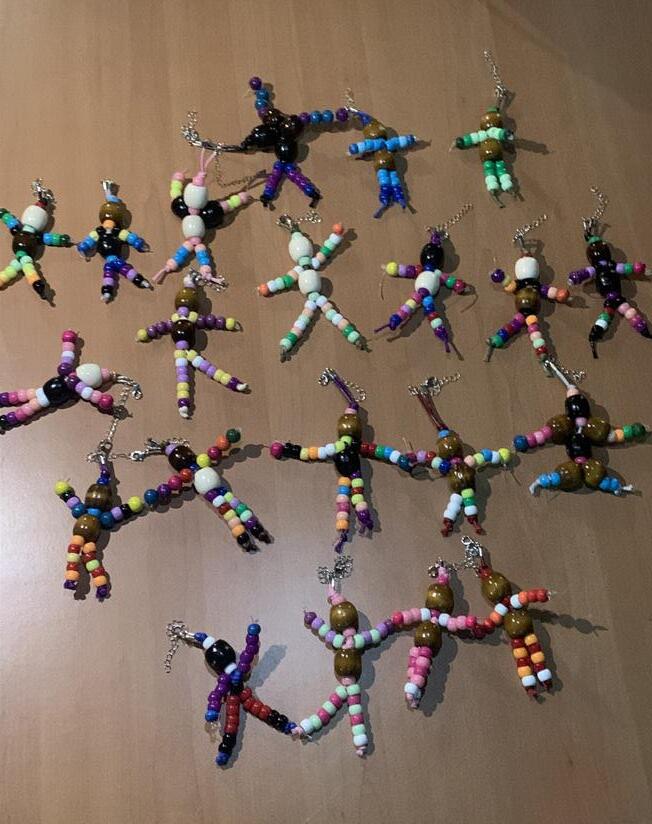
What informs your work?
Saffron Cherry:
Sarah: Coming from Toronto, I felt very isolated in the Edinburgh queer community. Out of all the countries I’ve lived in, I also found Edinburgh to be one of the most racist queer communities I’ve encountered. I really wanted a safe space for queer people of colour to be able to feel like they can be themselves without judgement, and to create a community full of love and support. Butch: To quote Roxane Gay,
“Who is really served by our misery when we can’t choose joy?”. Living in a very white city with a very white queer scene, in a very white country on TERF island, one doesn’t have to think too long about the answer to that question. There’s a really singular, raucous, and radical kind of joy that flourishes when queer people of colour are able to form community and feel safe and free to express it. That’s what we’ve been trying to create with Saffron Cherry, and are hopefully succeeding.
Exhale: Through our own experiences, we understand some of the issues that people in our community can face trying to find acceptance and belonging between the tensions of our cultures, religions and identities. It can be a difficult place to find yourself, stuck between the intersections of your identity. [In addition to] the general discrimination that LGBT+ folx and PoC face on an everyday basis - we can also face this within spaces that are meant to be safe for us. For example, we have experienced racism in LGBT-specific spaces
and queerphobia within spaces for PoC. This is why spaces for QTIPOC+, by QTIPOC+ are needed.
Have there been any standout moments from your events that have brought you joy?
Saffron Cherry:
Sarah: I really love hearing that friendships and relationships have started because of Saffron Cherry!
Butch: Actually seeing people of colour being in the majority for once at a cabaret in Edinburgh, and all of the positive feedback we’ve had from people at events! It’s just fantastic chatting to people and seeing everyone having a good time.
Mahasin from Exhale: Every event has brought me joy! It has been amazing to meet so many new people in the community, that I probably would never have the opportunity to connect with outside of Exhale. There is something about being in a room with people that you know accept the different parts of you, when others have
not, that is so healing. Being in that space together, hearing the laughs, seeing people come out of their shell more and express their gratitude for the space is really affirming and special.
Anything else you’d like to share with us?
Saffron Cherry: we’ll be doing a cabaret/club collab with Q’iwa the 22nd of September, 8-12 at the Wee Red Bar.
How can people get involved/support you?
Saffron Cherry: Give us a follow @saffron.cherry and come to one of our regular events! We also have a WhatsApp group chat you can request to join. We accept donations/tips (in our Linktree) to help fund future events and free tickets for attendees. You can also volunteer to help out any way you can! Just send us a DM if you’d like to join Saffron Cherry.
Exhale: If you identify as QTIPOC+, or are a PoC questioning your identity, you can find out about our upcoming events on Instagram, @exhale. group, or on our website www. exhale.group/events and sign up via Eventbrite. To get in touch with us about supporting our work or collaborating please email contact@exhale. group.
Exhale: Our new project Third Space, which launched in July, is an extension of Space to Be, and will provide a free monthly space until July 2025 with activities and food for QTIPoC+ to connect, create and enjoy! We are always looking for more people to get involved and find out more about what the community wants - please get in touch if you have any ideas or would like to work with us!
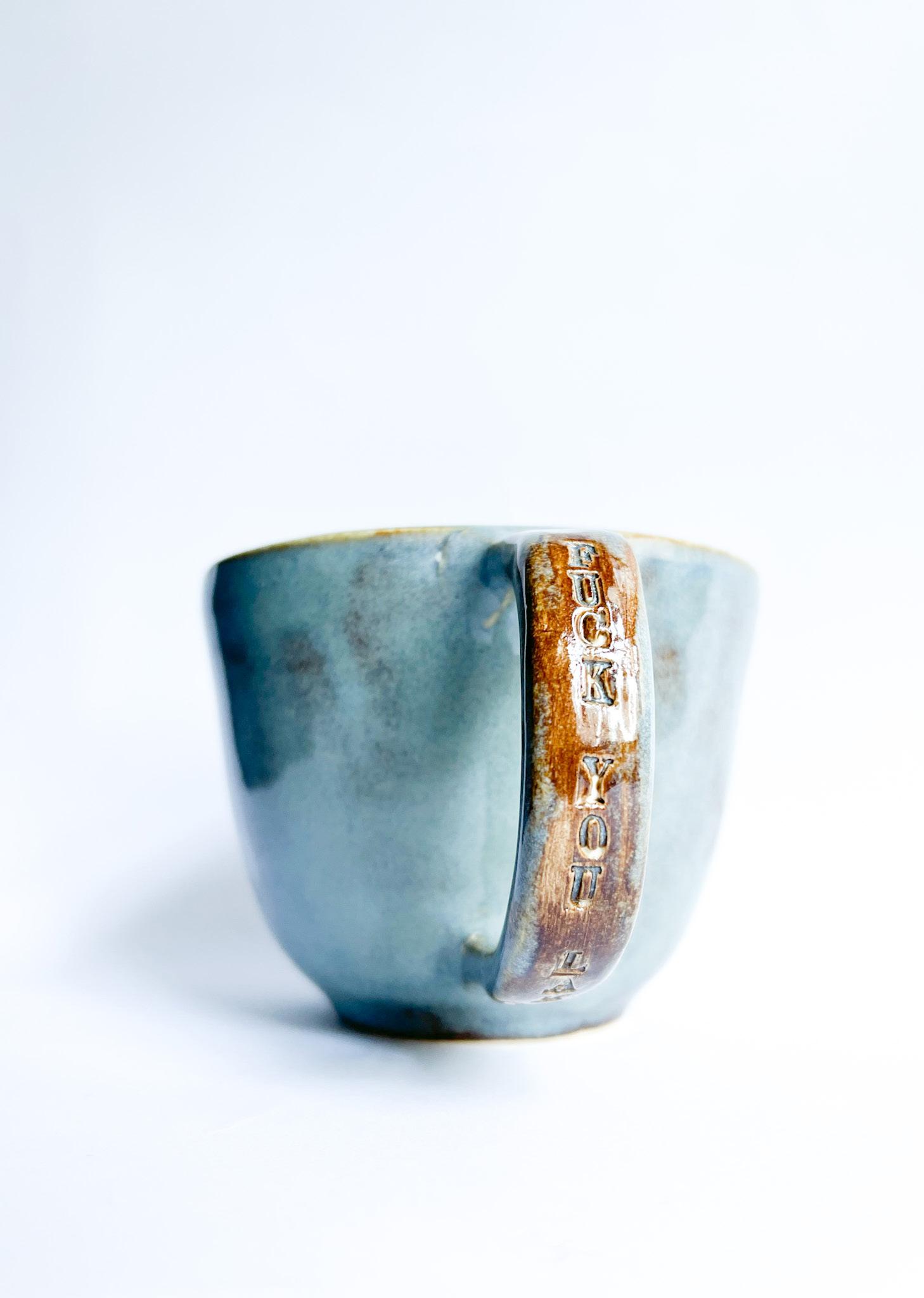
Fuck You Lah
by Zenda Tan
artwork
Reflections on Community
EXTRACTS FROM AN ARTICLE ONCE TITLED “HAS COMMUNITY BECOME NOTHING MORE THAN A MARKETING TOOL?”
BY HAZEL
PETERS
Many months ago I wrote an article for this zine called, “Has community become nothing more than a marketing tool?”. The article was a reflection on the term community and its function based on observations I’ve gathered while moving in artsy, charity, non-profit, social change, spaces (in-person and online). In the months between when I first wrote this article and the present moment (June 2024), my perspective on this topic has shifted and evolved. I no longer like the approach I took to the original article, and so I’ve chosen not to include it in the zine. However I do think my core argument is important, so below is a summarised version.
The choice to title the original piece “Has community become nothing more than a marketing tool?” was rooted in a key reflection I had. This reflection being: at times the word and concept of community is used as a marketing tool by brands, charities, and organisations to invoke feel-good connotations such as connection and belonging. I say it is a marketing tool because by using the language of community, a brand/charity/organisation can attract an audience (thus boosting their image and in
turn revenue) by playing on people’s desire for connection and support without fostering the collective care I believe is required for functioning ‘community’.
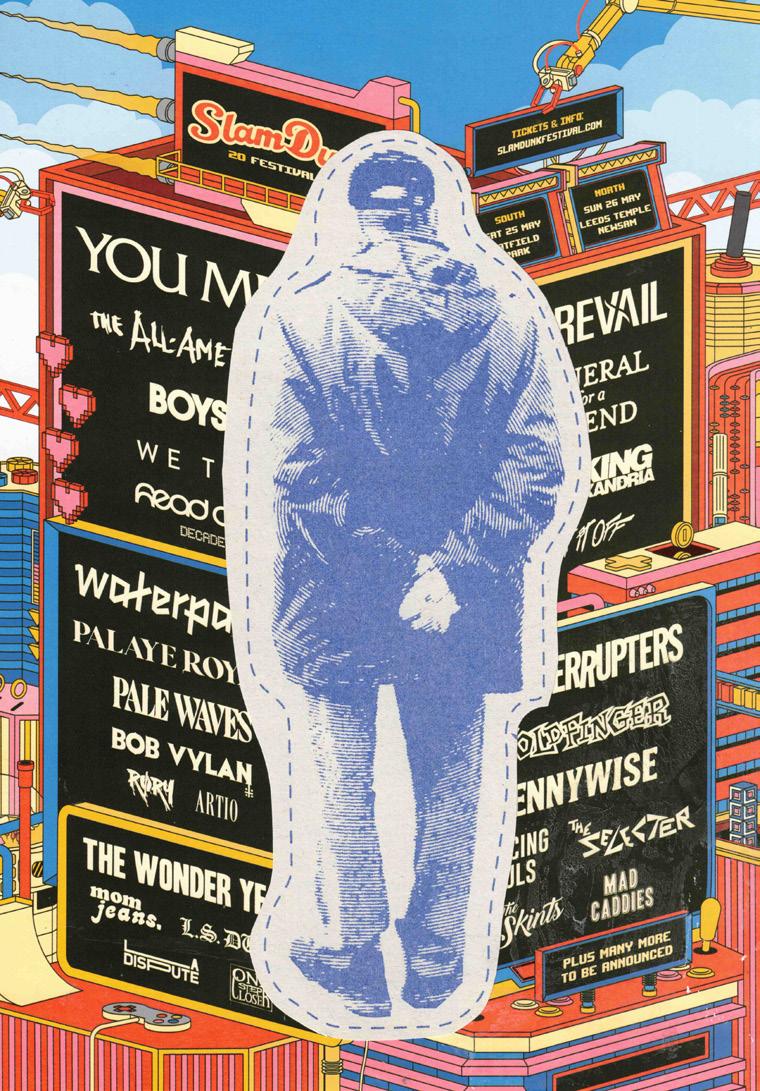
I went on to ruminate about the extent to which have I used the language of community as a tool to increase NPN’s public profile. I realised that I had been conflating a growth in NPN’s audience with a growth in our community. I also realised that I had/have been dressing up the work that NPN does (supporting BPoC, producing zines, hosting events, and offering moments of connection), as some super shiny, social change.
Creating space and representation for BPoC in Scotland is important, and I believe it plays a role in social change. However, in my experience, representation does little to alter the material, everyday conditions of marginalised people(s). It is with this understanding that I have begun to shift the way I think and speak about the work NPN does.
I hope some of what I’ve shared above resonates with, or prompts reflections in you the reader. If anything, let it be a reminder that our thinking can always evolve.
Scan
@NPNZINE on Instagram
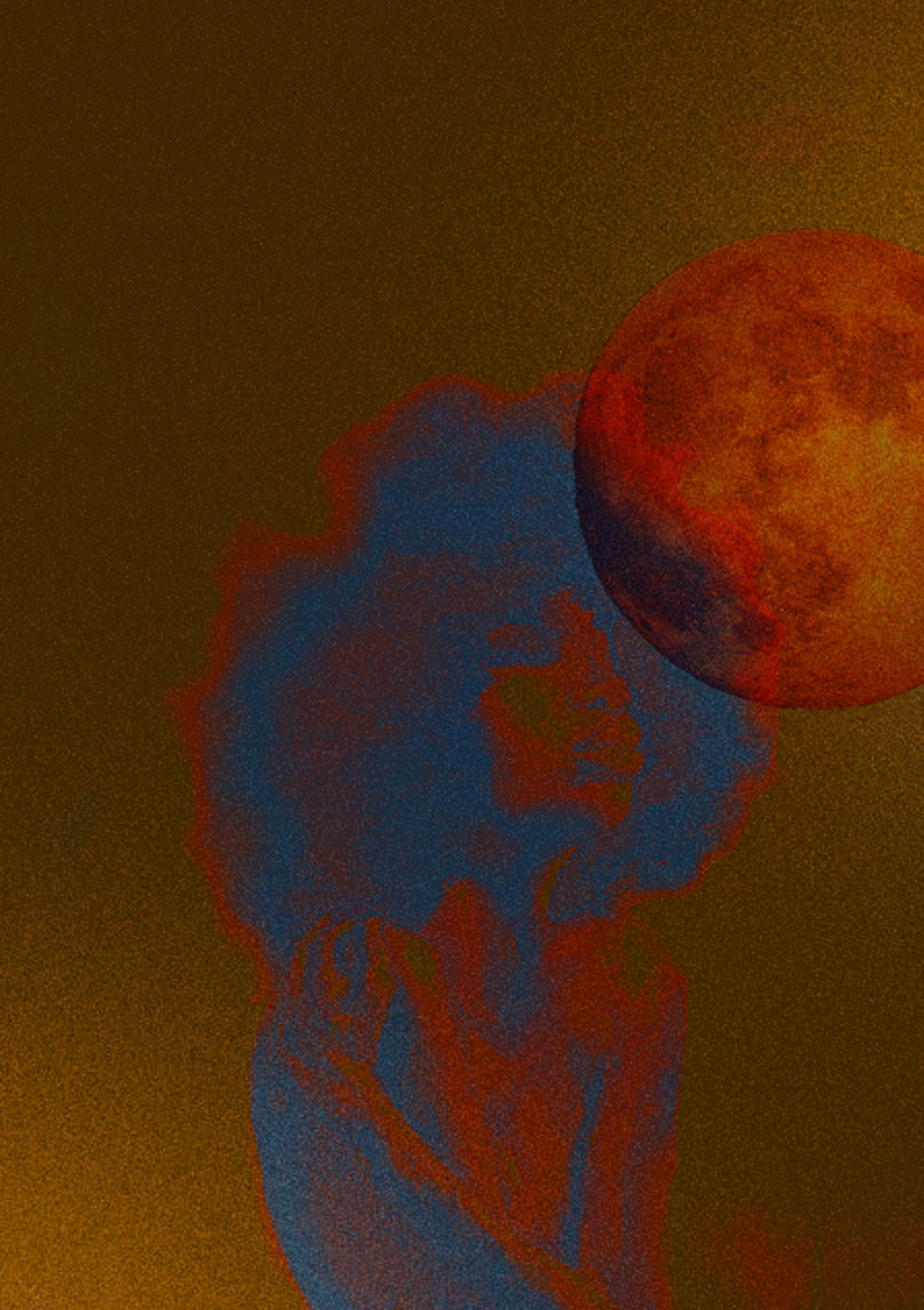
Zine Design by Eva
Lopez-Lopez
Front and Back Cover Art by Quinthia
Nsema

